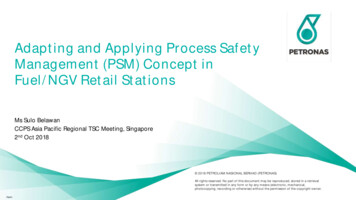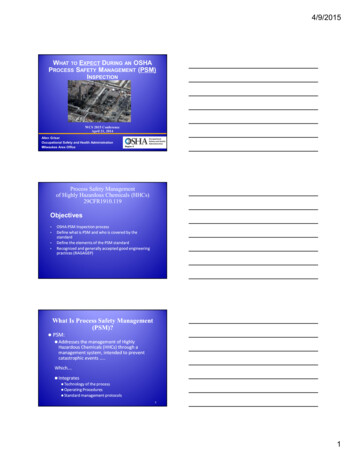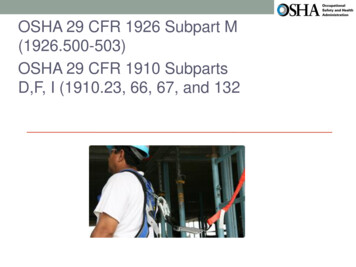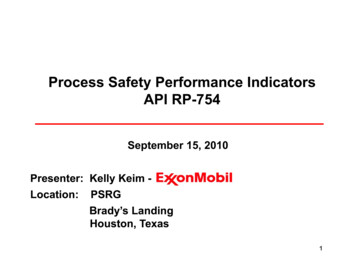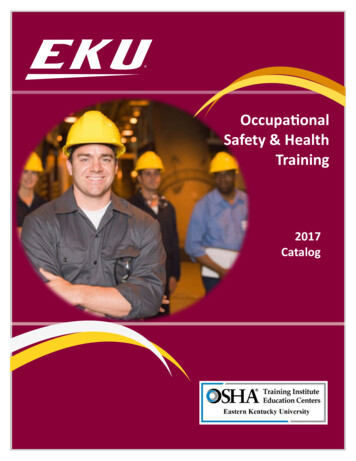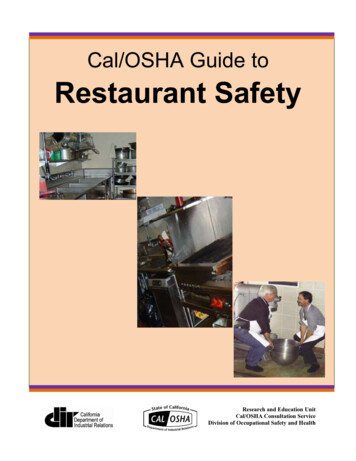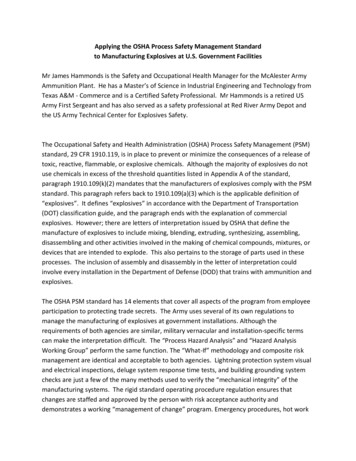
Transcription
Applying the OSHA Process Safety Management Standardto Manufacturing Explosives at U.S. Government FacilitiesMr James Hammonds is the Safety and Occupational Health Manager for the McAlester ArmyAmmunition Plant. He has a Master’s of Science in Industrial Engineering and Technology fromTexas A&M - Commerce and is a Certified Safety Professional. Mr Hammonds is a retired USArmy First Sergeant and has also served as a safety professional at Red River Army Depot andthe US Army Technical Center for Explosives Safety.The Occupational Safety and Health Administration (OSHA) Process Safety Management (PSM)standard, 29 CFR 1910.119, is in place to prevent or minimize the consequences of a release oftoxic, reactive, flammable, or explosive chemicals. Although the majority of explosives do notuse chemicals in excess of the threshold quantities listed in Appendix A of the standard,paragraph 1910.109(k)(2) mandates that the manufacturers of explosives comply with the PSMstandard. This paragraph refers back to 1910.109(a)(3) which is the applicable definition of“explosives”. It defines “explosives” in accordance with the Department of Transportation(DOT) classification guide, and the paragraph ends with the explanation of commercialexplosives. However; there are letters of interpretation issued by OSHA that define themanufacture of explosives to include mixing, blending, extruding, synthesizing, assembling,disassembling and other activities involved in the making of chemical compounds, mixtures, ordevices that are intended to explode. This also pertains to the storage of parts used in theseprocesses. The inclusion of assembly and disassembly in the letter of interpretation couldinvolve every installation in the Department of Defense (DOD) that trains with ammunition andexplosives.The OSHA PSM standard has 14 elements that cover all aspects of the program from employeeparticipation to protecting trade secrets. The Army uses several of its own regulations tomanage the manufacturing of explosives at government installations. Although therequirements of both agencies are similar, military vernacular and installation-specific termscan make the interpretation difficult. The “Process Hazard Analysis” and “Hazard AnalysisWorking Group” perform the same function. The “What-If” methodology and composite riskmanagement are identical and acceptable to both agencies. Lightning protection system visualand electrical inspections, deluge system response time tests, and building grounding systemchecks are just a few of the many methods used to verify the “mechanical integrity” of themanufacturing systems. The rigid standard operating procedure regulation ensures thatchanges are staffed and approved by the person with risk acceptance authority anddemonstrates a working “management of change” program. Emergency procedures, hot work
Form ApprovedOMB No. 0704-0188Report Documentation PagePublic reporting burden for the collection of information is estimated to average 1 hour per response, including the time for reviewing instructions, searching existing data sources, gathering andmaintaining the data needed, and completing and reviewing the collection of information. Send comments regarding this burden estimate or any other aspect of this collection of information,including suggestions for reducing this burden, to Washington Headquarters Services, Directorate for Information Operations and Reports, 1215 Jefferson Davis Highway, Suite 1204, ArlingtonVA 22202-4302. Respondents should be aware that notwithstanding any other provision of law, no person shall be subject to a penalty for failing to comply with a collection of information if itdoes not display a currently valid OMB control number.1. REPORT DATE2. REPORT TYPEJUL 2010N/A3. DATES COVERED-4. TITLE AND SUBTITLE5a. CONTRACT NUMBERApplying the OSHA Process Safety Management Standard toManufacturing Explosives at U.S. Government Facilities5b. GRANT NUMBER5c. PROGRAM ELEMENT NUMBER6. AUTHOR(S)5d. PROJECT NUMBER5e. TASK NUMBER5f. WORK UNIT NUMBER7. PERFORMING ORGANIZATION NAME(S) AND ADDRESS(ES)8. PERFORMING ORGANIZATIONREPORT NUMBERMcAlester Army Ammunition Plant9. SPONSORING/MONITORING AGENCY NAME(S) AND ADDRESS(ES)10. SPONSOR/MONITOR’S ACRONYM(S)11. SPONSOR/MONITOR’S REPORTNUMBER(S)12. DISTRIBUTION/AVAILABILITY STATEMENTApproved for public release, distribution unlimited13. SUPPLEMENTARY NOTESSee also ADM002313. Department of Defense Explosives Safety Board Seminar (34th) held in Portland,Oregon on 13-15 July 2010, The original document contains color images.14. ABSTRACT15. SUBJECT TERMS16. SECURITY CLASSIFICATION OF:a. REPORTb. ABSTRACTc. THIS PAGEunclassifiedunclassifiedunclassified17. LIMITATION OFABSTRACT18. NUMBEROF PAGESSAR2019a. NAME OFRESPONSIBLE PERSONStandard Form 298 (Rev. 8-98)Prescribed by ANSI Std Z39-18
permits, and pre-startup safety reviews are already engrained into the military way of doingbusiness.The elements of PSM are:1. Employee participation: Employers are required to have a written plan outlining theiremployee participation. Employee participation should begin at the inception of PSMimplementation. Such participation not only improves employee commitment to PSM,but a facility will end up with a much more viable implementation process. Theinvolvement should include employees at all levels of the organization, from fieldoperators, up through supervision, to operations management. The employeeparticipation program effectively includes workers and resolves their safety issues. Theparticipation should extend to every element of PSM. NOTE: The safety staff should be aresource for PSM, not the ones in charge of the program.2. Process Safety Information (PSI): OSHA states that PSI is “Complete and accurate writteninformation concerning process chemicals, process technology, and processequipment.” It is the information necessary for implementation of all other aspects ofPSM. Complete information on every chemical involved in the process, includingintermediates, is required. Process technology includes not only Process Flow Diagrams(PFDs) and Piping & Instrumentation Diagrams (P&IDs), but operating and storageconditions as well as operating procedures (see below) and operating history (forexisting processes). Process equipment information should include the underlying codesand standards relied upon, in addition to information about the specific equipment usedin the process. Explosives safety programs provide an understanding of the hazards andcontrol of detonation sources. These include: foreign objects in raw materials; use ofsubstitute raw materials; specific handling requirements for raw materials; impact bytools or equipment; impingement; friction; sparking; and static discharge.3. Process Hazard Analyses (PHA): A PHA is a systematic evaluation of the hazards involvedin the process. PHAs are required for initiation of a process and at least once every fiveyears after that. The PHA team should be multi-disciplinary, including maintenance,operations, and engineering. There are a variety of methods that can be used to conducta PHA. The method selected will depend on the maturity of the process and operationalexperience, in addition to process size and complexity. The facilitator of the PHA mustbe trained in the methodology being used. For proper conduct of a PHA, the PSI must beas complete as possible. Process hazard analyses include examination ofquantity‐distance requirements, building, design, human factors, incident reports, andlessons learned from explosives manufacturers. Operations in explosives manufacturingplants are separated by adequate intra-plant distances to reduce the risk ofpropagation. Unrelated chemical or industrial operations or facilities are separatedfrom explosives facilities using quantity distance guidelines. Facilities are designed toreduce secondary fragmentation that could result in the propagation of explosions
4. Operating Procedures: Operating procedures include not only the steps for normaloperations, but for upset conditions, temporary operations, start-up, and shutdown.Very important safety information must also be included in operating procedures. Suchinformation includes basic hazards of exceeding operational limits, appropriateresponse to upset conditions, safety and health information, and emergency operations.The procedures need to be up to date and reliable. They are also a critical element intraining of personnel.5. Training: Training is required for all employees new to a process before they becomeinvolved in that process. Training requirements extend beyond operating personnel toanyone involved in the process. This would normally include at least maintenancepersonnel and, possibly, contractors. The training must include the hazards of thechemicals and process and what is necessary to protect themselves, their fellowemployees, and their surrounding communities. Training should be bothwritten/classroom and hands-on. Employers must evaluate the effectiveness of trainingand make adjustments to content and frequency of training based on those evaluations.Explosives training and certification programs for workers and line managers provideand require demonstration of an understanding of explosives safety principles and jobspecific knowledge.6. Contractors: Employers using contractors need to ensure that use of those contractorswill not jeopardize the safety of operations. This starts with the selection process, wherethe employer needs to evaluate the safety performance and capabilities of potentialcontractors. Once selected, the employer must make sure that contractor employeeshave the appropriate skills and training to perform their work safely. The employer mustalso provide contractors with sufficient information/training to perform their jobssafely. Ongoing, the employer should keep a log of contractor injuries and illnesses (inaddition to its own employees) and periodically evaluate the safety performance of itscontractors. The contractors themselves also have various requirements, includingensuring that all of their employees are appropriately trained or informed to perform allof their responsibilities.7. Pre-startup Safety Review (PSSR): The Pre-Startup Safety Review is done before startupof a new operation or startup following a change in the process (see Management ofChange, below). It is a means for ensuring that all essential action items andrecommendations from the PHA have been completed prior to beginning operations. Itis also the point at which the design parameters and standards used for construction areverified. If training or modifications to PSI are necessary, completion of these items isalso verified during the PSSR. Startup should not be allowed to occur until all safetycritical PSSR items have been completed.8. Mechanical Integrity (MI): Employers are required to have a written program to ensurethe integrity of processes and equipment. Aspects include listing applicable equipment,
training of maintenance personnel, inspection and testing, and maintenance of suchsystems as controls, vessels, piping, safety systems, and emergency systems.Development and modifications to the mechanical integrity program should be madebased on operational experience, relevant codes, and industry standards.9. Hot Work Permit: Hot work permits must be issued for any work to be performed on, ornear, a PSM-covered process. While the OSHA standard specifically lists Hot Work,permits should be developed for any non-routine work to be performed in or aroundPSM covered processes. In addition to hot work, this could include line breaking,lock-out/tag-out, confined space entry, etc. Again, while the standard is titled “permit”,it really means an entire procedure covering all hazards of the work to be performed.10. Management of Change (MOC): “Change” includes anything that would require achange in Process Safety Information. This includes changes to equipment, processes,and instrumentation. A proper MOC system requires that any change be evaluated priorto its implementation. The level of evaluation can depend on the degree of change andits criticality to the safety of the operation. In addition to the evaluation and approval ofa change, MOC requires that suitable training be conducted (if necessary) and therelevant PSI be updated.11. Accident Investigations: Incident Investigation is required for any incident that did, orcould have, resulted in a release of a PSM-covered chemical. There are very specificrequirements for the timing of an investigation, the makeup of the investigation team,the resulting report, and the use/dissemination of the information obtained. If doneproperly, it is one of the primary tools for learning from the operation of a process. Itshould truly determine the root cause of an incident, not merely find someone orsomething to blame.12. Emergency Planning and Response: Employers are required to develop and implementan emergency action plan for the entire plant, not just the process(es) covered by PSM.It needs to address the actions to be taken in response to the release of any PSMcovered chemical. The plan needs to be comprehensive, including notification toemergency responders, operational responses such as shutdown, and precautions toprotect other employees and the public. There is a good probability that requirementsfor emergency response are also covered by other regulatory standards.13. Compliance Audits: Per OSHA, compliance audits must be conducted at least once everythree years. The purpose of the audits is to determine whether the practices andprocedures developed under the provisions of the PSM standard are being followed andare effective. The auditor(s) must be knowledgeable in PSM and should be impartial tothe facility being audited. According to OSHA, selection of appropriate auditors is“critical to the success of the process.” An audit report must be developed and the
employer must promptly respond to each of
standard, 29 CFR 1910.119, is in place to prevent or minimize the consequences of a release of toxic, reactive, flammable, or explosive chemicals. Although the majority of explosives do not use chemicals in excess of the threshold quantities listed in Appendix A of the standard, paragraph 1910.109(k)(2) mandates that the manufacturers of explosives comply with the PSM standard. This paragraph .
